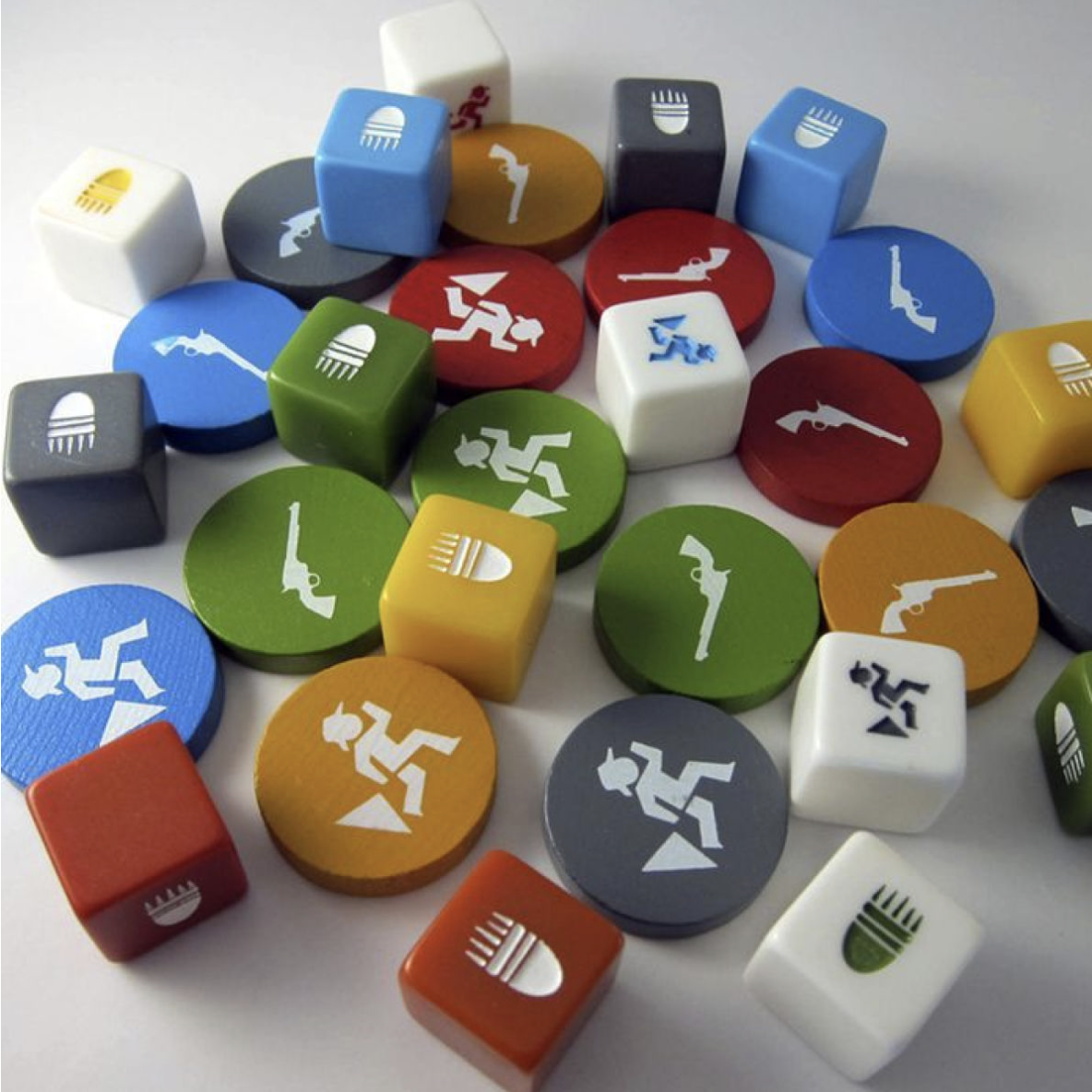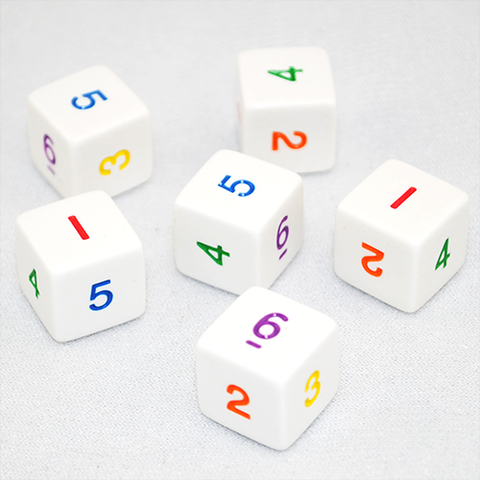I saw the figure 6, underlined in white
33Why would a six-sided die need an underline on its 6 to indicate it’s not a 9?
This is the latest installment in a regular series of researched and reported stories that @dave asked me to write about things of broad interest to the community. Previous articles have tracked down the history of SHOUTY CAPS and the decoder hardware built into the Voyager probes.
It’s a little thing on dice that show figures rather than pips (or dots) for numbers — a small line under the numeral 6 on a six-sided die. On a die that starts with 1 and has more than eight sequential numbers, it makes sense: you need to differentiate between a 6 and a 9. In some dice designs the two digits can be distinct, but they often look near enough to a 180-degree rotation. Even close attention can’t easily tell the two apart. (Some dice may use an underline and others a dot to the lower right of the numeral.)

But why on a simple cube? I asked Shari Spiro, the president of AdMagic Games and Breaking Games. She works with independent game designers to turn their ideas into physical products. Max Temkin of Cards Against Humanity calls her an unofficial additional partner in the game, given her close collaboration with the company. Spiro says, “Nobody has a job like mine: I print Cards Against Humanity!”
Spiro estimates she brokers about a million dice a year among the games she produces. She seemed surprised herself when we added up the total. One game alone, Boomtown Bandits, sports 25 dice and ships about 10,000 units a year, forming a quarter of that production total.

Why that underline? Spiro says, as is true with so many kinds of low-cost, high-volume manufacturing tasks, dice are mostly made in China. Dice typically get made through injection molding, in which molten plastic is injected into a cavity that’s exactly the negative shape of the thing you want to make. This cavity is a mold tool, often shortened to just tool.
Almost everything plastic you have that isn’t a flat or slightly molded sheet — including items that seem like they’re made of something else due to sheen, smoothness, or finish — are injection-molded plastic. To make the tool, you need, oh, no, a die. Not that kind of die! This die isn’t a thing with spots or figures on its sides that you roll, but rather a piece of metal used to form or stamp other metal or to act as a shape for vacuum formed plastic, like those impenetrable product shells. (Now you know the meaning of “tool and die,” seen on a lot of industrial shops: they makes dies and tools for manufacturing lines!)
(The word die in both senses is from uncertain origins. The Oxford English Dictionary speculates it derives from Latin “datum” [given] through French, and was used to mean a result “given” by chance. Die as in stamping out something doesn’t have a separate origin story, but the notion of having shapes imposed on the sides of something may be how it got its name.)
Why talk about this other kind of die? Because dice tools are made from dies. Dies are expensive to make (as are tools), and both dies and tools are reused. Spiro says, “There are just tens of thousands already made” in standard forms. Even though many people in China know and use Arabic numerals, Chinese has its own numbering system. “It’s clearer for the Chinese, if you’re making it in China” when there’s an underline on the 6 and the 9 in the correct orientation, Spiro says.
The number “has to have an orientation in relation to the other sides,” she says. Even if Arabic numerals are your native counting system, it’s one fewer thing for a tool maker to lose track of.

Spiro says there are several less obvious reasons, too: for people with low vision or dyslexia, an underlined 6 is much easier to recognize than one without. And for speed play games, you need to identify a number quickly without your brain going through extra steps.
There’s one more explanation to add to that: some dice don’t feature sequential numbers starting at 1! If you have a game in which 6 or 9 might appear on a die with fewer than nine sides, the underline is a requirement or you have to memorize which die have which figures on them.
(Spiro is full of other fascinating dice information. Only a handful of Chinese plants can meet her specifications. Some dice are etched and have colored filled in while others are printed using silkscreening. Matching colors, while it has automated steps, requires expert craftspeople. Adding custom dice to a game can increase its retail price as much as $10. Some game designers prefer dice with pips to have the ⚃ and ⚅ — 4 and 6 — to have the pips in the corners the same; others want different spacing. Balance is critical: “They have to be balanced and they have to roll randomly, and it has to be true random, and it has to be provable, otherwise they’re loaded dice.”)
I looked for more academic and clinical opinions on the legibility of dice, but it seems like a gap in psychophysics, the study of how perception works. I was unable to find anyone who has done work in that area.
I did get some insight from a somewhat related field, however. Fernard Gobel is the professor of decision making and expertise at the University of Liverpool’s Department of Psychological Sciences, and he notes via email, “The human perceptual system is very adaptive and learns quickly, so people who use a specific type of dice are likely to learn to perceive the numbers rapidly whatever their shape (within reasonable limits).”
That is, you can train yourself to recognize what’s on a die, even when it might initially be ambiguous. But this reinforces the need on an arbitrary die to have clarity so that you’re not developing this understanding while you’re also playing the game.
The mystery of the superfluous underline or tiny dot makes more sense when you dig more deeply into it. While it can involve cost savings through reusing dies and molds, it also helps with time shavings: leveling the figurative playing field by evening out cognitive differences in quickly recognizing a number as it lands in front of you.
Glenn Fleishman writes about blank pages, 19th Century type design, and modern bike-sharing systems. He’s the 2017 designer in residence at the School of Visual Concepts in Seattle.
- 14 comments, 4 replies
- Comment
So glad you’re writing here on another topic!
I cherish these. Your work is always so interesting.
Thanks.
Wow so interesting
TL:DR the 6 is underlined so you know it’s a 6.
@medz lol … My “real” TL;DR :
Dice are made in China where they elect to include the underline due to less familiarity with Arabic numbers.
Yeah nothing wrong with redundant or reinforced information.
@awk
Nothing wrong with reading the work of someone who simultaneously hasa fascinating curiosity and very good writing skills.
@awk You can say that again.
@mehcuda67 Nothing wrong with reading the work of someone who simultaneously has a fascinating curiosity and very good writing skills. [Saying that again w/ corrected word spacing…]
What if you were blind, or had poor sight. If the indentation that has the color is great enough to feel…
Back in my D&D days, I would have called that a “biased” die, not “loaded.” Loaded would designate a die that was intentionally used to alter otherwise-random results in one’s own favor, most often with a 50%+ outcome for one particular number. A good GM would roll and record results for his own dice a large number of times in order to ascertain bias. Occasionally, he might employ biased dice to push the adventure in a particular direction.
/roll 1d9
 You rolled a total of 9
You rolled a total of 9
/captionbot

 I think it’s a close up of a cup.
I think it’s a close up of a cup.
/captionbot

 I think it’s a white plate.
I think it’s a white plate.
/giphy surprise six

There’s this GameScience dice guy who is (or was…I guess I’m not positive he’s still alive) a total fanatic about making sure dice are exactly the same size.
https://www.awesomedice.com/blog/353/d20-dice-randomness-test-chessex-vs-gamescience/
He has a good demo, which is just making multiple stacks of ten dice and comparing the heights. His were all the same, while others varied quite a bit. Oh, I found a picture of this. I love how ‘high school science fair’ this looks:

I think he’s got a good point. But most people I knew weren’t looking for true random enough to pay extra for ‘true’ dice.
Well written!
I’ve collected dice since I was a kid (even though I didn’t play any games), but I’ve never collected dice trivia. Maybe I should start.
Just figured out, I wasted precious time reading but one comment